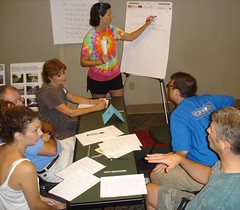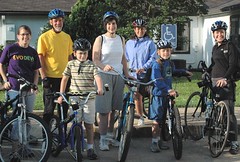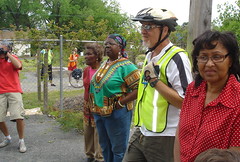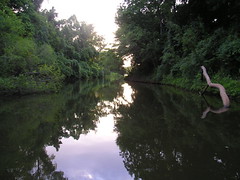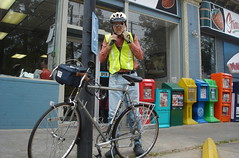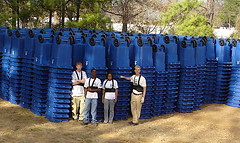Sharron Swanson sent me this draft of an article on greenways. It's very thorough and should answer a lot of questions people might pedestrian-bike paths, linear parks, and the like.Please note that the article is a draft, and is copyright protected; do not cite or use it without permission of the author.
-----------------------
Happy Trails: Greenways for Everyone
by Hannah Twaddell
Believe it or not, some people's lives are improving because of
America's skyrocketing gas prices. Bicycle and pedestrian planners are
suddenly finding themselves very popular as people scramble to find
ways to cut back on their driving.
According to a recent USA Today/Gallup Poll, 84 percent of Americans
are changing their travel habits in response to the gas crisis. Where
folks once thought nothing of hopping in the car for every trip, they
are now consolidating errands, carpooling, taking transit, bicycling
and walking whenever they can. Bike shop owners like Hervey Hawk at
Cycle Cave in Albuquerque are doing a brisk business in repairs for
people who are "dragging 30 and 40 year old bike out of the garage" so
they can ride them to work. What's more, many of us are coming to
believe that high gas prices are here to stay. These "alternative"
forms of transportation may well become the norm for us over the next
few years.
Adding to people's desire for bike and pedestrian routes --
particularly greenway trails -- is the growing nationwide concern over
the public health problems related to our sedentary lifestyles.
Greenways offer an attractive, safe way to get everyone outside for
exercise, from children struggling with obesity to seniors wishing to
stay active. Veteran greenways planner Charlie Denney of Alta Planning
+ Design says people at public workshops are no longer asking, "why
should we spend money on trails?" but "when can we get them under
construction?"
What Are Greenway Trails?
A greenway is any open space corridor that is managed for
conservation, recreation, and/or transportation. A greenway trail is a
linear corridor with protected status that provides public access for
recreation or transportation. [footnote: Trails for All Americans,
National Park Service and the American Trails coalition] Greenway
trails can be found within natural corridors, such as a riverfronts,
stream valleys, or ridgelines, or man-made routes such as railroad or
utility rights-of-way, canals, or scenic roads. [footnote: As you
embark upon a plan, be sure to clarify whether you are proposing a
greenway, a trail, or both. A greenway can be created for the purpose
of land preservation, not necessarily with a trail. A trail is a
public pathway that may or may not traverse a greenway that is
protected through purchase or easement. Some landowners are willing to
donate, sell, or grant easements for a greenway but not a trail.
Others are willing to support the trail but don't want restrictions on
the land.]
A cost-effective, low-impact way to connect people and places
together, greenway trails typically link parks, nature reserves,
cultural features, or historic sites with each other and with
communities. They can be paved or unpaved, and designed to serve a
variety of trail users, including hikers, walkers, joggers,
bicyclists, skaters, horseback riders, and people with disabilities.
Up until a few years go, greenways were largely considered a
recreational amenity by transportation professionals and local
residents. But a shift in thinking has started to happen. People begin
by using the trails for recreation, but then start finding ways to
access them from local streets. From there, it's not long before these
interconnected networks are used for everyday transportation.
Communities of all sizes are designing greenways that tie into streets
and sidewalks, forming one continuous bicycle/ pedestrian network. For
example, the Philadelphia East Coast Greenway plan aims to connect
major tourist destinations and city neighborhoods into Center City.
The Louisville Loop will connect more than 100 miles of trails and
sidewalks throughout the city, while rural Montgomery County, VA,
recently completed a plan to link five villages.
Creating Greenways: A Four-Step Path
Step 1) Organize: Cultivate a sustainable, citizen-led advocacy group
with strong leadership and a clear vision. Most of America's greenways
and trails have been created by community members. The keys to
long-term success are two-fold: leadership and support.
The most important element is a core leader or leaders who have a
clearly articulated vision and the ability to recruit others to help
realize it. The ideal candidate for project leader is someone who has
strong communication skills and can foster teamwork; understands how
government works; is sensitive to people's varying needs and desires;
and has tenacity and patience.
The second key element is to sustain the effort over the long haul by
forming an efficient, well-managed team. Citizen leaders should
include people from communities along the proposed corridor as well as
potential user groups, businesses and civic organizations. The group
should actively engage public and private planners, engineers, and
administrators of preserves and parks as well as transportation
facilities.
Step 2) Plan: Create a plan that enjoys broad public support
First, develop a simple conceptual plan and mission statement to share
in one-on-one or small group meetings with public officials, community
leaders and, especially, landowners along the proposed corridor.
Soliciting this early input is critical to success. This is not a time
for negotiating easements or talking about public funds, but a time to
let people know about the group's vision and, most importantly, to
listen to their ideas and concerns.
To write the full-fledged plan, engage professionals in landscape
architecture, community and recreation planning, public participation
techniques, civil engineering, and architecture. Public agency staff
may be able to do this in-house, but the most effective approach is
usually to hire consultants who specialize in greenway planning.
Organizations such as Rails to Trails and the American Planning
Association as well as public agencies such as state departments of
transportation and parks/ recreation, maintain consultant databases
and can provide ideas for developing Requests for Proposals. If public
funds are used to develop the plan, it's important to follow the
relevant agency procurement requirements.
The plan should include a physical inventory of the proposed corridor
area(s), ideally produced in a series of GIS map layers that can be
kept up to date. Key data includes:
-- topography
-- hydrology and flood plains
-- wildlife habitats
-- existing or residual environmental contamination
-- roadways and roadbeds, rail lines (active and abandoned), trails,
and other engineered facilities
-- public services and utilities
-- scenic resources
-- historic and cultural resources
-- demographic and socio-economic characteristics of the community and
potential trail users
-- parks, open spaces and community facilities
-- current and planned land uses
--property ownership
The plan should include an analysis of trail demand among community
residents and visitors, displayed on a map of estimated trips at
various points. [footnote: A standard reference for estimating trail
demand is the US DOT Compendium of Available Bicycle and Pedestrian
Trip Generation Data in the United States.] Another element is an
assessment of potential economic benefits such as increased property
values and business revenues; new jobs; increased corporate relocation
and retention, and collateral development such as B&B's and regional
tourism. [footnote: The National Park Service publication Economic
Impacts of Protecting Rivers, Trails, and Greenway Corridors is one of
many useful resources on estimating economic benefits of potential
trails].
Thirdly, the plan's feasibility must be considered. Consider the
likelihood of acquiring the land and funding for construction and
maintenance; gauge the level of public support; and determine which
entities could own and operate it.
All of this information is assembled into a draft master plan that is
ready to share with stakeholders and the larger community. Then a more
detailed trail development plan can be developed that shows elements
such as access points, road crossings and bridges, gates and culverts,
and amenities such as information kiosks and rest rooms. The plan also
provides an overall design theme that supports the intended trail
users, and is consistent with the character of the surrounding
community. Finally, it identifies an implementation strategy with cost
estimates and funding sources, as well as approach for ongoing trail
management and maintenance.
Step 3) Build: Acquire right-of-way and construct well-designed paths
The most challenging part of many greenway development projects is
right-of-way acquisition. It helps to understand real estate law and
negotiation tactics in order to acquire the necessary titles, leases,
easements, and/ or access agreements. In addition to the tedium of
legal process, this is the stage when misperceptions can stall
enthusiasm. Landowners and municipal governments often worry about the
liability of allowing public access to their land. Get familiar with
state codes and municipal insurance policies -- they usually provide
indemnification for greenways.
Another misperception is that trails will invite crime and/or reduce
property values. In fact, properties in the vicinity of trails tend
to sell faster and for a higher price than neighboring
lands.[footnote: Trails and Greenways: Advancing the Smart Growth
Agenda, Hugh Morris, Rails to Trails Conservancy, 2002, Page 19]. And
studies show that trails can actually help reduce crime by attracting
people to formerly abandoned areas." [footnote: Rail-Trails for Safe
Communities, by Tammy Tracy and Hugh Morris of the Rails to Trails
Conservancy for the National Park Service, 1998. page 1]. For
instance, the Baltimore-Annapolis rail/trail was built in an abandoned
area of Anne Arundel County that had been plagued by drug dealers.
Within six months of the trail opening, no arrests were being
reported, and businesses were starting to move into the area. "Once it
was re-created as a place people wanted to go," says Charlie Denney,
"the crime went away."
Greenway trails, like all public spaces, do benefit from simple design
techniques to reduce the likelihood of crime, such as lighting,
call-boxes, and well-pruned shrubbery. Many trails are policed by
volunteer or professional patrols. Arlington, VA and Louisville, KY
trail markers are color-coded with a GPS location in the city's
emergency-911 database, allowing trail users with cell phones to tell
police where they are.
When designing and building trails, it's important to adhere to basic
construction standards, from clearing foliage and establishing the
foundation to managing runoff and water crossings. Trails must also be
designed to support all desired users. Low-hanging branches are all
right for hikers, but not for cyclists and equestrians. [footnote:
Useful resources include The Rails-to-Trails Conservancy's Trails for
the Twenty-Fist Century and Greenways, A Guide to Planning, Design,
and Development, and How Greenways Work and the Trail Construction &
Maintenance Notebook by the National Park Service. ]
Funding sources for trail planning and construction include federal
monies such as US DOT Transportation Enhancement grants and the
National Park Service Rivers, Trails, and Conservation Assistance
program as well as state and local DOT and parks/recreation programs
and private funds from foundations and donors. Municipalities can
also negotiate with or require developers to incorporate trails into
their projects. [footnote: When working with a developer, make sure
the trail is properly engineered and that is built concurrent with the
rest of the project. Everyone loves trails when they're part of a new
development, but opposition is inevitable when you try to build them
after folks have moved in.] Smart developers are realizing that
greenways are a fairly low-cost investment that can considerably raise
the value of their project these are amenities people want.
Step 4) Operate: Administer and maintain the greenway system
It's very important to make sure trails are well maintained. Costs
vary widely depending on the size and complexity of the system, but
one should budget for tasks such as the following:
Routine Maintenance
-- Daily security patrol and cleaning of comfort stations
-- Weekly refuse removal and grass cutting
-- Monthly and post-storm maintenance inspections
-- Quarterly brush cutting
-- Seasonal and post-storm clearing of culverts and drains
-- Snow and debris removal and minor repairs
Long-Term Maintenance
-- Inspect bridges and tunnels yearly
-- Repaint blazes and repaint buildings every 5 years
-- Resurface trail every 10 years
-- Renovate buildings every 10-20 years
Greenway managers also have to supervise professional and/or volunteer
staff; raise operational funds and administer the budget; manage
conflicts between users, and implement trail policies, as well as
maintaining good relations with the community and continuing to plan
for future trail development. [footnote: Useful references on trail
operations and maintenance include the following: US Department of
Agriculture -- Forest Service, Technology and Development Program.
Publication 4E42A25 -Trail Notebook. (1996). Trail Construction and
Maintenance Notebook. Missoula, MT:USDA-FS Missoula Technology &
Development Center; and US Department of the Interior -- National
Park Service, Denver Service Center. NPS-2023. (1992). NPS Trails
Management Handbook. Washington, D.C.: U.S. Government Printing
Office.]
Municipalities should allocate annual funds for management and
maintenance as well as capital improvement funds for major work. If
the trail spans multiple municipalities, cost-sharing agreements can
be established. A DOT may work out an agreement with a municipality
for maintenance of trails in the state right of way. Privately
operated trails are usually maintained with donor dollars and
volunteers.
Summing Up
Local planners and officials are well advised to get ready for rapidly
increasing pressure from the public to improve and expand our networks
of sidewalks, bike routes, and multi-use trails. If your community
already has a greenways plan in place, start looking for ways to put
more money into construction. If you don't, it's high time to get your
planning efforts underway.
------------------------------
--------------
Hannah Twaddell is a Senior Transportation Planner in the
Charlottesville, Virginia, office of Renaissance Planning Group. Her
"Forward Motion" column appears regularly in the Planning
Commissioners Journal.
--------------------------------------------
** Please note that the above article is copyright protected. Please
contact us at: editor@plannersweb.com before copying or distributing
this article for anything other than your own personal use.
--------------------------------------------


